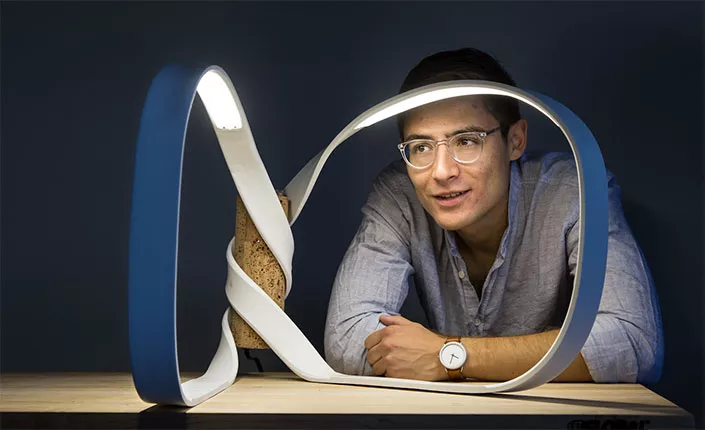Entrepreneur Eduardo Umaña ’15 Fuses Contour and Craft, Profit and Purpose

Umaña's senior design project: a lamp you can turn on and off by whistling.
Eduardo Umaña ’15 has designs on being a different kind of entrepreneur.
“I want my products to do well, but it’s also very important to me to do good,” says the recent gradate in engineering who moved from Colombia to Miami, Fla., when he was 16.
“I believe it’s my generation’s responsibility to improve the status quo and to effect social change," he says, "and that entrepreneurship can actually be a very effective tool in those spheres.”
Through Classic Engineering, Umaña makes and manufactures sustainable products like the Classic NATO watch, fusing contour and craft. He defies what he considers the imaginary boundary between engineering and design and rejects expectations for high-quality, ethically produced goods coming cheaply.
“When we pay more for a product, we appreciate it more, and we get better quality,” he says. “We use it longer, which is good for the environment. And we’re able to pay more to the people who made it. Everyone benefits.”
Umaña’s entrepreneurial journey started the summer after his sophomore year. After missing out on a prized internship, he traveled to Scandinavia with his family.
“I woke up one day and just said, ‘I want to make a watch,’” he says. “That’s the way it goes for me. Usually, project ideas coming out of nowhere.”
Umaña used 3-D modeling software to create a blue and plastic prototype, but soon realized the features and technicalities made it impossible to manufacture. His re-designs yielded the aluminum body, ceramic coating, sapphire glass, and handmade leather straps. Umaña designed the components and sent the parts for manufacturing, then received the finished materials in March.
“I spent my entire spring break assembling 75 watches and putting them in boxes,” he says.

The classic NATO watch
Umaña discussed his plan for the watch at Swat Tank, the student business plan competition, in April, receiving positive feedback from peers and faulty. The watches are available — and selling — on the Classic Engineering site in three colors. And they could soon be joined by Umaña’s latest creation: an inventive lamp that you turn on and off by whistling.
“I just thought it would be cool to have light coming out of two loops, that it would be an interesting way to cast light on something,” he says of what became his senior design project thesis.
Umaña toiled on the form and function of the lamp, making two prototypes before nailing the continuous, stand-alone shape of his final product.
The first step was finding an oven long and hot enough to thermoform six-foot strips of epoxy resin. Umaña and Carr Everbach, professor and chair of the Engineering Department, thought about using the oven at nearby Renato Pizza, but realized that wouldn’t work because of the fumes the lamp would emit. So Umaña designed and fabricated an oven in the basement of Hicks Hall before laser-cutting the strips for the lamp at NextFab in Philadelphia.
Then came the technical work to get the lamp to respond to a whistle.
“Long and tedious,” Umaña says of that process. “I had no experience making circuit boards, and there’s really no instruction manual for working with microprocessors. I had to go really deep into computer systems to write the algorithm in C.”
Umaña struggled to balance hardware and software challenges, but his efforts paid off when it came time to present the project to his classmates.
“I said to someone in the audience, ‘Please whistle,’ and the lamp turned on,” he said. “It was so nice to see it work in real time.”
That Umaña realized his vision for the project didn’t surprise Everbach, who worked closely with the budding creator for years.
“Eduardo has a keen sense of aesthetics, a vision of what he wants,” he says. “His time at Swarthmore may have taught him some ways of achieving that vision, but mostly it showed him that you have to jump in and teach yourself what you need to know.”
In his junior year, Umaña received a grant from The Halpern Family Foundation to develop a coffee grinder and Everbach arranged for him to do fabrication work at NextFab that couldn’t be done on campus.
“In that way, Eduardo could reach his goals, but I could also use his experiences to the benefit of future students,” says Everbach. “Eduardo was a trailblazer, and I felt that supporting his projects laid the groundwork for future Swarthmore students to reach in creative, entrepreneurial engineering directions.”
Umaña's Swarthmore collaborations included an internship with Joey Roth ’06, who has his own design studio and product line. Umaña also subscribes to industrial designer Dieter Rams’ “Ten Principles of Good Design,” among them, "Good design is honest." These and other inspirations course through the DNA of Classic Engineering, along with some lessons Umaña gleaned from his time at Swarthmore.
“If I learned something here, it was to find the right motivation for doing things,” he says. “A lot of companies are just motivated to make money, but my motivation is to make things that people will enjoy and will do good for society. I think if you start with that motivation, the money will come after.”



